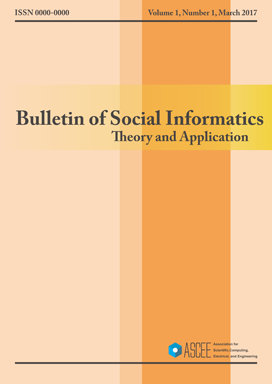Social Media Addiction and its Impact on Social Relationships
DOI:
https://doi.org/10.31763/businta.v6i1.407Keywords:
Social relationships, Social media, Social media addiction, Impact of social mediaAbstract
Social media is a platform that allows users to engage in activities and collaborate. Social media can make communicating with fellow humans easier via a smartphone connected to an internet connection. But on the other hand, the presence of social media can have a negative impact. Excessive use of social media can be addicting and can have a negative repercussion on one's social relationships. Therefore, this paper will analyze the relationship between social media addiction on social relationships and how it impacts one's social relationships. To analyze that, a research instrument in the form of a questionnaire was used. After that, the validity and reliability tests were carried out regarding the questionnaire. If the questionnaire passed the test, the questionnaire was distributed. The results from the questionnaire were analyzed by an assumption and hypothesis test respectively,, to describe the objectives of this study.
References
W. N. Listia, “Anak Sebagai Makhluk Sosial,†J. BUNGA RAMPAI USIA EMAS, vol. 1, no. 1, pp. 14–23, Jun. 2015, doi: 10.24114/JBRUE.V1I1.9278.
M. I. Akbar, T. K. Chandra, R. A. Setyowati, F. Isnaeni, S. L. Zahro, and A. D. Yuniar, “Interelasi kecerdasan sosial dengan interaksi sosial mahasiswa luar Jawa Fakultas Ilmu Sosial Universitas Negeri Malang,†J. Integr. dan Harmon. Inov. Ilmu-Ilmu Sos., vol. 1, no. 5, pp. 598–604, May 2021, doi: 10.17977/UM063V1I5P598-604.
M. Danuri, M. Informatika, J. Teknologi, and C. Semarang, “PERKEMBANGAN DAN TRANSFORMASI TEKNOLOGI DIGITAL,†J. Ilm. Infokam, vol. 15, no. 2, Sep. 2019, doi: 10.53845/INFOKAM.V15I2.178.
J. Pembangunan, P. : Fondasi, D. Aplikasi, M. Ngafifi, S. Negeri, and S. Wonosobo, “KEMAJUAN TEKNOLOGI DAN POLA HIDUP MANUSIA DALAM PERSPEKTIF SOSIAL BUDAYA,†J. Pembang. Pendidik. Fondasi dan Apl., vol. 2, no. 1, Jun. 2014, doi: 10.21831/JPPFA.V2I1.2616.
Bulletin of Social Informatics Theory and ApplicationISSN 2614-0047Vol. 6, No. 1, March 2022,pp. 53-64Maftuh Ahnan et.al (Social media addiction and its impact on social relationships).
A. Setiadi AMIK BSI Karawang Jl Banten No, “Pemanfaatan Media SosialUntuk Efektifitas Komunikasi,†Cakrawala J. Hum. Bina Sarana Inform., vol. 16, no. 2, 2016, doi: 10.31294/JC.V16I2.1283.
A. A. Nur, S. Hajar, S. Prodi, P. Bahasa, and I. Umpar, “The library research ; the effectiveness of social media on EFL learners speaking skill,†La Parol. J. Lang. Teach. Pedagog., vol. 3, no. 2, pp. 104–122, Sep. 2021, Accessed: Apr. 05, 2023. [Online]. Availableat: jurnal.umpar.ac.id.
C. Juditha, “Hoax Communication Interactivity in Social Media and Anticipation (Interaksi Komunikasi Hoax di Media Sosial serta Antisipasinya),†J. Pekommas, vol. 3, no. 1, pp. 31–44, Sep. 2018, doi: 10.30818/JPKM.2018.2030104.
E. Dwi and S. Watie, “Komunikasi dan Media Sosial (Communications and Social Media),†J. Messenger, vol. 3, no. 2, pp. 69–74, Mar. 2016, doi: 10.26623/THEMESSENGER.V3I2.270.
“Digital 2021 -We Are Social UK.â€, Available at : wearesocial.com.
“Social Media Use in 2021 | Pew Research Center.â€Available at : pewresearch.org.
A. M. Kaplan and M. Haenlein, “Users of the world, unite! The challenges and opportunities of Social Media,†Bus. Horiz., vol. 53, no. 1, pp. 59–68, Jan. 2010, doi: 10.1016/J.BUSHOR.2009.09.003.
P. A. Cakranegara and E. Susilowati, “Analisis Strategi Implementasi Media Sosial (Studi Kasus Ukm ‘Xyz’),†FIRM J. Manag. Stud., vol. 2, no. 2, Sep. 2017, doi: 10.33021/FIRM.V2I2.337
.K NurMutiaSundawati, “Penggunaan Media Sosial Instagram Dalam Upaya Meningkatkan Hasil Belajar Dan Motivasi Siswa Kelas Xi Pada Materi Sel,†2018, Available at : unpas.ac.id.
H. Miftahurrahmah and F. Harahap, “Hubungan Kecanduan Sosial Media dengan Kesepian pada Mahasiswa,†Acta Psychol., vol. 2, no. 2, pp. 153–160, Oct. 2020, doi: 10.21831/AP.V2I2.34544.
H. Nassaji, “Qualitative and descriptive research: Data type versus data analysis,†vol. 19, no. 2, pp. 129–132, Feb. 2015, doi: 10.1177/1362168815572747.
Willis F.Overton, “Life-Span Development: Concepts and Issues,†pp. 1–29, 1997, Accessed: Apr. 06, 2023.Availableat: researchgate.net.
H. Taherdoost, “Validity and Reliability of the Research Instrument; How to Test the Validation of a Questionnaire/Survey in a Research,†SSRN Electron. J., Aug. 2016, doi: 10.2139/SSRN.3205040.
M. T. Kane, “Book Reviews: Test Validity,â€, vol. 14, no. 3, pp. 291–296, Sep. 1989, doi: 10.3102/10769986014003291.
Sultoni, I. Gunawan, and D. N. Sari, “Validity and Reliability of Character Education Internalization Instruments,†pp. 245–249, Dec. 2019, doi: 10.2991/COEMA-19.2019.50
“Guilford, J. P. Fundamental Statistics in Psychology and Education. New York (330 West 42nd Street):McGraw-Hill Book Company, 1956. 565 P. $6.25,†Sci. Educ., vol. 41, no. 3, pp. 244–244, Apr. 1957, doi: 10.1002/SCE.3730410357.
S.Arikunto, Prosedur penelitian : suatu pendekatan praktik / Suharsimi Arikunto | OPAC Perpustakaan Nasional RI.Rineka Cipta 2010, 2010. Accessed: Apr. 06, 2023. Availableat: opac.perpusnas.go.id.
D. Andrich and I. Marais, “Reliability and Validity in Classical Test Theory,†pp. 41–53, 2019, doi: 10.1007/978-981-13-7496-8_4.
Melissa J. Goertzen, “Applying Quantitative Methods to E-book Collections, ,†pp. 5–31, Accessed: Apr. 06, 2023. [Online]. Availableat: journals.ala.org.
“Razali, N. and Wah, Y. (2011) Power Comparisons of Shapiro-Wilk, Kolmogorov-Smirnov, Lilliefors and Anderson-Darling tests. Journal of Statistical Modeling and Analytics, 2, 21-33. -References -Scientific Research Publishing.â€Available at :scirp.org.
M. N. Mohamad Asri, N. H. Hashim, W. N. S. Mat Desa, and D. Ismail, “Pearson Product Moment Correlation (PPMC) and Principal Component Analysis (PCA) for objective comparison and source determination of unbranded black ballpoint pen inks,â€, vol. 50, no. 4, pp.323–340, Jul. 2016, doi: 10.1080/00450618.2016.1236292.
Downloads
Published
How to Cite
Issue
Section
License
Copyright (c) 2022 Bulletin of Social Informatics Theory and Application

This work is licensed under a Creative Commons Attribution-ShareAlike 4.0 International License.




